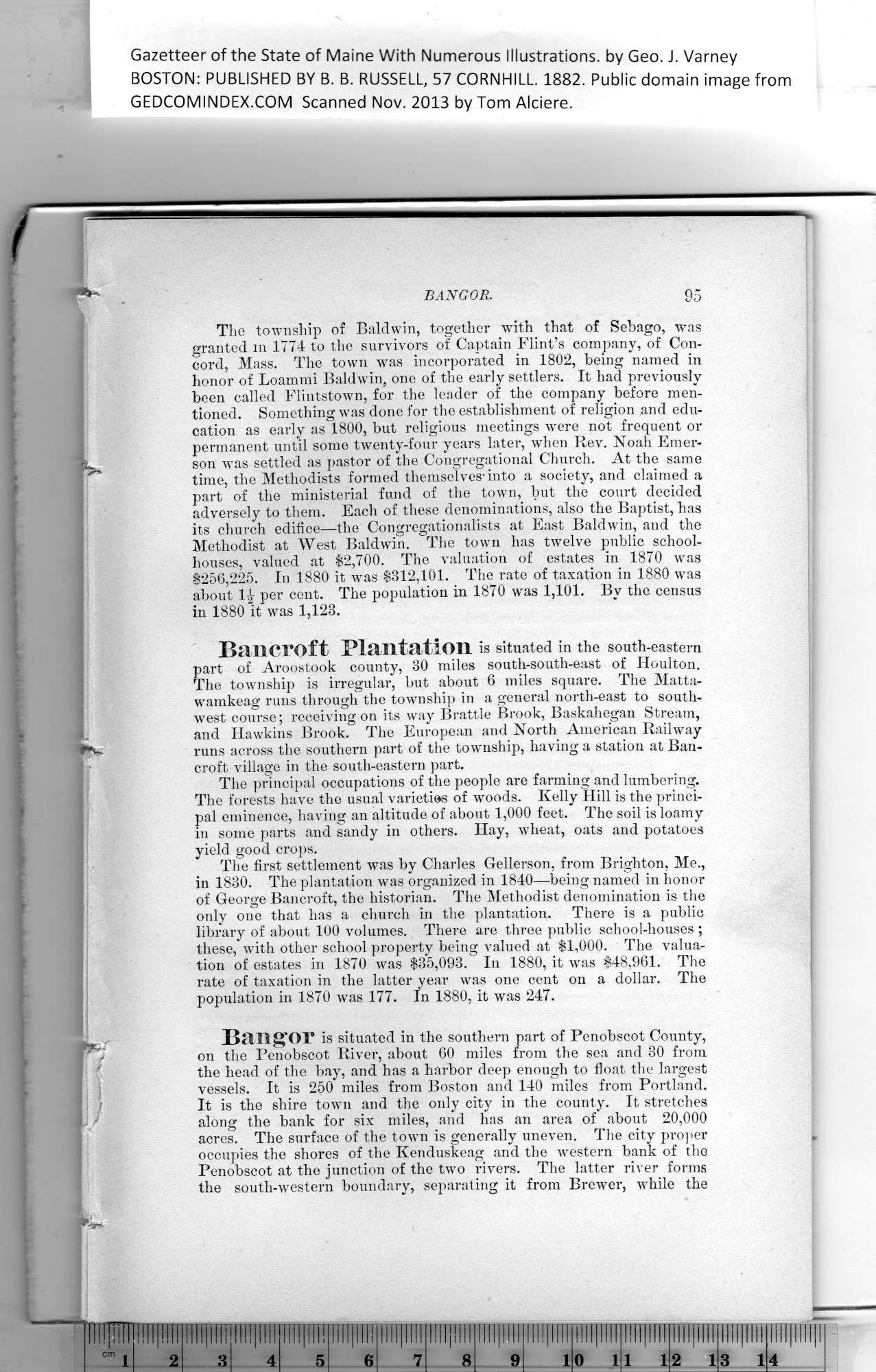|
Gazetteer of the State of Maine With Numerous Illustrations, by Geo. J. Varney
BOSTON: PUBLISHED BY B. B. RUSSELL, 57 CORNHILL. 1882. Public domain image from
r— -
■'**' BANGOR. 95
The township of Baldwin, together with that of Sebago, was
granted m 1774 to the survivors of Captain Flint’s company, of Con-
cord, Mass. The town wras incorporated in 1802, being named in
honor of Loammi Baldwin, one of the early settlers. It had previously
been called Flintstown, for the leader of the company before men-
tioned. Something was done for the establishment of religion and edu-
cation as early as 1800, but religious meetings were not frequent or
permanent until some twenty-four years later, when Rev. Noah Emer-
son was settled as pastor of the Congregational Church. At the same
time, the Methodists formed themselves- into a society, and claimed a
part of the ministerial fund of the town, but the court decided
adversely to them. Each of these denominations, also the Baptist, has
its church edifice—the Congregationalists at East Baldwin, and the
Methodist at West Baldwin. The town has twelve public school-
houses, valued at $2,700. The valuation of estates in 1870 was
$256,225. In 1880 it was $312,101. The rate of taxation in 1880 was
about 1£ per cent. The population in 1870 was 1,101. By the census
in 1880 it was 1,128.
Bancroft Plantation is situated in the south-eastern
part of Aroostook county, 30 miles south-south-east of Houlton.
The township is irregular, hut about 6 miles square. The Matta-
wamkeag runs through the township in a general north-east to south-
west course; receiving on its way Brattle Brook, Baskahegan Stream,
and Hawkins Brook. The European and North American Railway
runs across the southern part of the township, having a station at Ban-
croft village in the south-eastex-n part.
The principal occupations of the people are farming and lumbering.
The forests have the usual varieties of woods. Kelly Hill is the princi-
pal eminence, having an altitude of about 1,000 feet. The soil is loamy
in some parts and sandy in others. Hay, wheat, oats and potatoes
yield good crops.
The first settlement was by Charles Gellerson, from Brighton, Me.,
in 1830. The plantation was organized in 1840—being named in honor
of George Bancroft, the historian. The Methodist denomination is the
only one that has a church in the plantation. There is a public
library of about 100 volumes. There are three public school-houses ;
these, with other school property being valued at $1,000. The valua-
tion of estates in 1870 was $35,093. In 1880, it was $48,961. The
rate of taxation in the latter year was one cent on a dollar. The
population in 1870 was 177. In 1880, it was 247.
Bangor is situated in the southern part of Penobscot County,
on the Penobscot River, about 60 miles from the sea and 30 from
the head of the bay, and has a harbor deep enough to float the largest
vessels. It is 250 miles from Boston and 140 miles from Portland.
It is the shire town and the only city in the county. It stretches
along the bank for six miles, and has an area of about 20,000
acres. The surface of the town is generally uneven. The city proper
occupies the shores of the Kenduskeag and the western bank of the
Penobscot at the junction of the two rivers. The latter river forms
the south-western boundary, separating it from Brewer, while the
PREVIOUS PAGE ... NEXT PAGE
This page was written in HTML using a program written in Python 3.2
|
